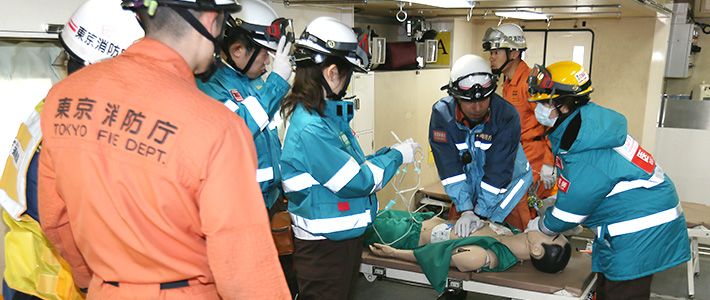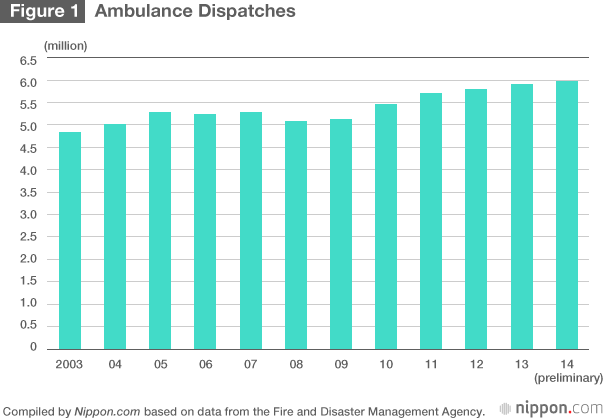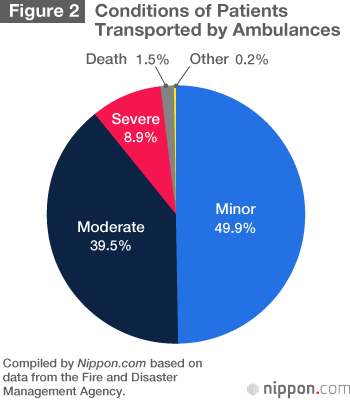
Japan’s Ambulance Services in Need of Emergency Care
Politics Society Lifestyle- English
- 日本語
- 简体字
- 繁體字
- Français
- Español
- العربية
- Русский
Record High Ambulance Dispatches
The sharp increase of ambulance calls is turning into an emergency situation with services in Japan nearing capacity. According to the Fire and Disaster Management Agency, dispatches have increased 20% in the last 10 years, reaching a record high of 5.98 million in 2014. This is more than 16,000 dispatches per day on a nationwide basis. While the increase is partially attributable to the high number of heatstroke victims seen in recent heat waves, the principal cause is the growing number of ambulance calls for the elderly.

The 2014 FDMA white paper shows that 8.9% of persons transported by ambulances had severe medical conditions, while 49.9% had minor conditions in which hospitalization was unnecessary. In some cases, people with minor conditions called ambulances for highly inappropriate reasons, such as to go to a dentist, to avoid walking to the hospital, or to keep from having to call a taxi.

Debate over Charging for Services
The growing demand for ambulance services has renewed talk of charging for their use, an issue that has been under consideration for more than 10 years. On May 11, 2015, the Ministry of Finance held a meeting of the Fiscal System Council, where a proposal on local government finances included a statement on exploring the need to charge for ambulance services for minor medical conditions. The proposal points to the necessity of prioritizing emergency response for patients truly requiring ambulance services. The ministry hopes that such a change would contribute to reducing fire service and related expenses, which exceed ¥2 trillion a year.
The proposal cited examples of overseas fees charged for ambulance services, including about ¥50,000 for fire department responses in New York, a basic fee of about ¥67,000 in Munich, Germany, and 60 to 120 Singapore dollars for nonemergency responses in Singapore.
Opponents to fees argue that Japanese citizens widely view free ambulance service as an essential part of the safety net. Some also maintain that ill people may avoid calling ambulances and worsen their condition if forced to pay for emergency services. In addition, there is the broadly held view that any shortage of ambulances to transport patients with severe illnesses or injuries should be addressed by increasing numbers, even if this means a higher public expense.
People taking a sympathetic view toward ambulance charges contend that since it is difficult to determine beforehand whether a medical condition is minor or severe, a system should be instituted to bill for ambulance transport when the medical condition is found to be minor. Others assert that private patient transport vehicles should be approved as emergency vehicles when certain conditions are met.
Longer Response Times
What can we learn about the state of ambulance service from a city like Tokyo? In fiscal 2014, ambulances were dispatched on 757,600 occasions, an increase of 1.1% from the previous year, and the highest figure on record since the Tokyo Fire Department began ambulance services in 1936. The department’s ambulance dispatches averaged 2,075 per day, or once every 41 seconds. Of the 664,249 people transported, 228,097, or about one-third, were aged 75 or older.
What is being considered problematic is the transport of people with nonurgent conditions. According to the TFD, the ratio of people transported by ambulance for medical conditions that were later determined to be minor was 51.9% in 2014, down from a peak of 60.3% in 2006.
Another issue is response time. In 2003 it took on average 6 minutes and 18 seconds for an ambulance to arrive on a scene. In 2014, increasing demand pushed this up to 7 minutes and 54 seconds.
According to the FDMA, the average time from calling 119, Japan’s emergency telephone number, to arriving at a hospital was about 39 minutes nationwide in fiscal 2013, which is about 10 minutes longer than a decade earlier. This is also seen as a consequence of increasing ambulance calls, with more ambulances having to be dispatched from distant fire departments.
Japan’s First Ambulance Service
Japan’s first ambulance went into operation in 1931 at the Osaka branch of the Japanese Red Cross Society. Local governments were mandated to begin providing fire and ambulance services with the revision of the Fire Service Act in 1963.
Japan has developed an advanced system supporting air and water ambulances, and ground ambulances have been improved to provide better life support. In 1991, the Emergency Life-saving Technicians Act took effect, enabling emergency medical technicians to provide prehospital care while transporting patients.
(Originally written in Japanese by Harano Jōji of Nippon.com and published on August 31, 2015. Banner photo: Firefighters of the Tokyo Fire Department and members of a Disaster Medical Assistant Team train in Tokyo with a specialized ambulance on March 6, 2015. © Jiji.)Ministry of Finance Emergency medical services aging of society ambulance dispatch Fire and Disaster Management Agency Japanese Red Cross Society fire service